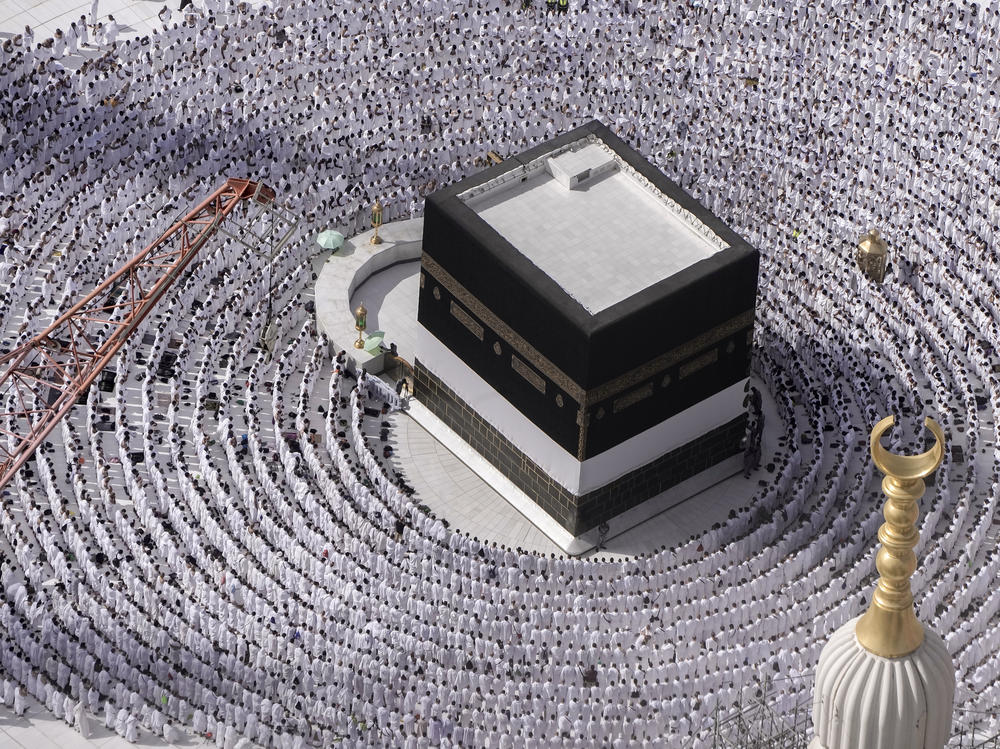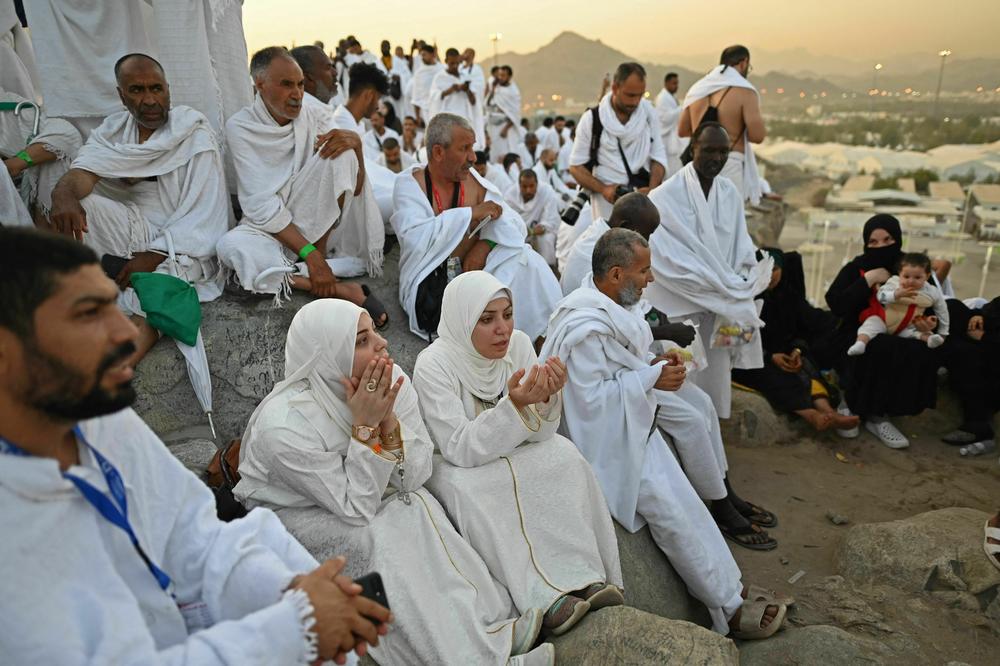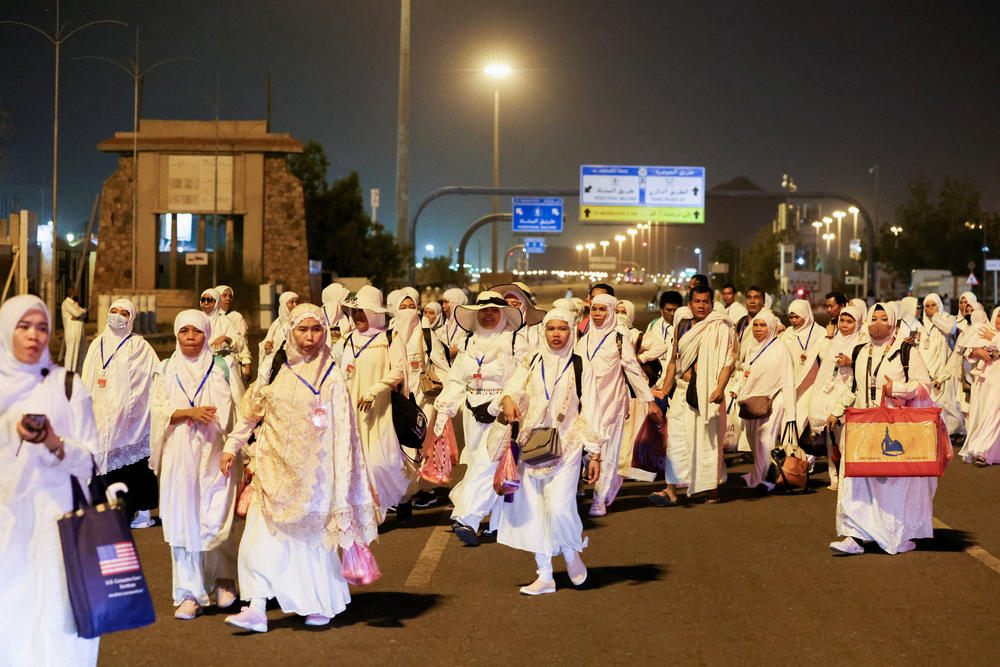Section Branding
Header Content
Standing where Prophet Muhammad gave his final sermon, 2 million Muslims perform Hajj
Primary Content
Updated June 27, 2023 at 11:16 AM ET
DUBAI, United Arab Emirates — Around 2 million Muslims are converging Tuesday in the valleys and hills around Mecca for the pinnacle day of the annual Hajj pilgrimage. They're gathering at Mount Arafat, where the Prophet Muhammad delivered his final sermon about 1,400 years ago.
This is the largest pilgrimage since 2019, after which the Hajj was dramatically curbed due to coronavirus restrictions that limited the gathering to just a few thousand people.
Here, men and women spend the day in deep prayer and, in what is known as duaa and dhikr, practices in which Muslims recite Allah's name, they read the Quran and pray for forgiveness, healing and mercy.
It's here, in the area of Mount Arafat on a hill called Jabal al-Rahma, or Mountain of Mercy, where the Prophet Muhammad told his followers in his final sermon that just as men have certain rights over women, that women, too, have rights over men. He described women as partners who must be treated well and with kindness.
He also spoke about racial equality in his sermon, saying that no person has superiority over the other based on ethnicity or race. He said distinction comes only through piety and good deeds. He called for unity and brotherhood among Muslims.
The seamless white terrycloth robes worn by male pilgrims are intended to embody that spirit of unity, so simple in appearance as to make one's status and wealth nearly indistinguishable. Women are required to forgo makeup, perfume and other aesthetics during the Hajj, letting go of material trappings. They dress modestly in head coverings.
Egyptian pilgrim Haitham Abuwafiya, 41, said he has experienced random acts of kindness from other pilgrims on the Hajj. He said an Algerian man seated near him offered to share his meal rather than waste the food. In another example, a South African man was buying doughnuts in a food court in Mecca and insisted on buying for Abuwafiya, who was standing in line behind him.
"I told him I have money, but he insisted on paying," he said. "You don't feel strange or that someone else [from another country] is strange to you. Everyone is here for the same reason, for God and worship. People are compassionate and the mood is great."
Rituals of the Hajj
While the Hajj in Islam follows the path the Prophet Muhammad once walked, it's also believed to trace the paths the prophets Ibrahim and Ismail once took, or as they're known in the Bible, Abraham and Ishmael.
Women also play a role in the history of the Hajj through the story of Ibrahim's wife, Hajar (known as Hagar in the Bible).
As part of any pilgrimage to Mecca, Muslims walk between two hills seven times, retracing Hajar's search for water for her dying son before a spring appeared that runs to this day there. The sacred well of Zamzam continues to provide drinking water for pilgrims.
That path between the hills today is marbled, shaded and has multiple floors to accommodate the large number of pilgrims performing this ritual known as sa'i, which represents life's tribulations, God's mercy and life's constant movement.
Another key part of the Hajj is circling the Kaaba seven times and reciting prayers.
"Before anything, you have to have conviction," Abuwafiya said about the Hajj. "You have to believe in it."
The Hajj takes roughly five days to complete, including three days in Mina, a large tent city where Muslims cast stones at pillars in a symbolic act meant to represent the casting away of sins and spiritual renewal.
The Hajj is one of the largest and most logistically challenging gatherings of people on Earth. It consistently poses a challenge for Saudi authorities as they host people and manage crowds from nearly every country in the world. The kingdom also has mobile clinics and has built hospitals near the various stops of the Hajj to treat pilgrims who need it.
In 2015, more than 2,000 pilgrims died in Mina when crowds converged down a narrow street, causing a crush of people and stampede. The incident drew criticism over the kingdom's management of the crowds, which were supposed to be directed down one-way roads to avoid this from happening.
The meaning of Hajj
Muslims who are physically and financially capable are required to perform the Hajj once in a lifetime. Many save up a lifetime to perform the Hajj while others rely on donations and charity to make the journey.
With flights, buses, accommodation and visas through authorized Hajj operators, the cost can vary around $1,000 per pilgrim to tens of thousands for those who can afford the upscale hotels overlooking the Grand Mosque in Mecca.
Muslims believe the Hajj offers a chance to wipe away past sins by surrendering to God for mercy and strength.
The Hajj coincides with several days of Eid al-Adha celebrations, in which Muslims around the world commemorate the Prophet Ibrahim's test of faith. On the first day of the Eid, Muslims slaughter livestock and distribute its meat to those who cannot afford to buy and eat it.
Most pilgrims will spend a minimum of two weeks in and around Mecca for the Hajj, and many will also travel to the Saudi city of Medina before departing the kingdom to visit what is known as the prophet's mosque, where Prophet Muhammad is buried.
Copyright 2023 NPR. To see more, visit https://www.npr.org.




